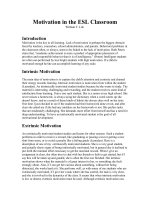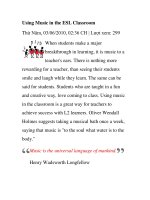Real Audio to Augment Real Listening in the ESL Classroom
Bạn đang xem bản rút gọn của tài liệu. Xem và tải ngay bản đầy đủ của tài liệu tại đây (101.15 KB, 7 trang )
Real Audio to Augment Real Listening in
the ESL Classroom
Frank Tuzi
Introduction
One of the faster growing tools available for education and entertainment is Real Audio
(RA) by Progressive Works Inc. Real Audio is a software package that allows users to
listen to sounds and watch videos on or off the Internet. The RA player is free and the
player/recorder is $30.00.
After downloading this program, people can listen to radio programs like music, talk radio,
and Hollywood interviews. There are also educational programs for distance education,
family programs for family issues, children's programs, religious programs, etc.
Benefits for ESL
How can this program benefit an ESL curriculum? First of all, Real Audio is a program
students can use to get information. The selection of information on the Internet is vast and
varied enough to satisfy the interests of almost any student. Allowing students to choose
the information they will listen to or watch is inherently motivating (Nunan, 1993).
Furthermore, allowing students to pick and choose increases their confidence in being
independent learners. Additionally, since the information is recorded, they can listen to or
see it over and over again, an option they don't have in the real world or in broadcasted
information like radio or television. Also, the materials are not limited to one or two voices.
Unlike many ESL tapes, students can listen to a variety of voices and thus, improve their
listening ability. Another benefit is that students have the opportunity to listen to real
English, that is, English for native speakers, allowing students to enjoy the full flavo! r
inherent in authentic English speech (Mead, 1985). Even better than having real English is
real spontaneous speech (Ur, 1984). Spontaneous speech, that is spoken language that is
not written out or prepared in advance, is what ESL/EFL students will hear most. Since
most heard speech is spontaneous, ESL students benefits by having an abundance of
impromptu speech available. Some of the radio programs on the Internet include talk
shows, i.e. unprepared speech.
RA is also useful in reading classes. Some of the sites listed at RA have sound clips and
transcripts allowing users to read and listen at the same time. Being able to perform both
activities increases comprehension, memorization and motivation. Other sites have audio
books. Books like Moby Dick and The Catcher in the Rye are dramatized in audio format.
Audio books allow students to "read" a story in 30 minutes.
Although there are a variety of benefits to using RA in the ESL classroom, teachers and
students should be aware of some potential problems. For instance, because the amount of
vocabulary is so great, many foreign language students who possess a smaller supply may
feel frustrated. Thus, the amount of appropriate materials may be limited, or the teacher
may need to decide what materials the students use. Another language drawback is that
some of the sound clips are lengthy. A typical audio book is about 25 minutes long. Shorter
clips are easier for ESL Students to digest. The longer students practice at one sitting, the
weaker his listening skills become during that sitting (Ur,1984). Therefore, it is wise to
select appropriate materials for beginning students.
Another obvious limitation is the need for a computer and Internet access. Anyone with a
computer and a sound card, can use RA. This program does not require direct Internet
access for it to work. However, in order to listen to the Real Audio files users must have
access to them, and the files are on the Internet. If a teacher or school has even one
computer that has Internet access, however, many of the necessary files can be
downloaded. Many locations on the Internet allow users to download the RA files. For
example, Earth and Sky, a site dedicated to educating people about astronomical and
environmental issues, allows visitors to download any information from their site. They
have a daily radio program that lasts about a minute and a half. A teacher or administrator
can easily download dozens of files from this site and then make those files available to the
rest of the school.
Having looked at the advantages and some possible drawbacks, I would like to suggest
some possible uses of RA in the ESL Classroom.
Real Audio in the Classroom
The first step in using Real Audio is to download a free version or purchase RA at
After installing the program, begin selecting
sites of interest for students. I have made a sample list for those teachers with little time to
search the Internet. See Table One.
Table 1. A Sample list of Real Audio sites for ESL
Science
Earth & Sky
Space Zone
The Discovery Channel
News
NPR
The BBC Online
The Osgood Files
Sports
Audio Net-Sports
ESPN Sports Zone
Literature
Audio Net
Bible
The Online Book Page
Radio
Audio Net
The Talk Network
World Radio Network
There are a variety of ways that RA can enhance an ESL classroom. If the Internet is
available to the entire class, students can pick and choose what they will listen to by going
to RA and picking a site among the thousands that they have listed. A teacher with limited
access to the Internet will need to download files of interest and make those files available
to the class. Once students and teachers choose the sound clips, they need to be
incorporated into the curriculum. Here are some suggestions for incorporating RA sound
clips into the ESL classroom.
Procedures
Keeping a Journal
Have students keep a journal about the sound clips that they listen to. Students write a
summary of each sound clip they select. The journal need not be on paper. The journal can
also be on tape or could be a RA sound clip, in which case students would record a
summary of each sound clip. In addition students can mention likes and dislikes, what
things they learned from the sound clips and finally record any new vocabulary they
learned through the sound clip.
Guessing Definitions
If the teacher has downloaded some file, they can listen through the clip and write down
any new words that they want the class to learn. Then the teacher puts the words on a
practice sheet for students to guess the meaning. For example, imagine your students are
listening to the April 11, 1996 episode of Earth and Sky, The topic is the Sound Barrier.
The students will hear: es960411.ram
Sound is produced by vibrations in the air around our planet. The speed of sound is 760
miles an hour at sea level -- although this speed can vary a little under different conditions
of altitude, temperature and wind. When an airplane tries to travel faster than sound, a
wave of compressed air builds up ahead of the plane. That1s why the speed of sound
proved to be a formidable barrier to pilots. As they approached it, their aircrafts' controls
would "lock" or freeze. The pilots themselves began speaking of a "sonic wall" or "sound
barrier" that no one had crossed. Chuck Yeager was the first to break the sound barrier -- to
travel faster than sound -- in the year 1947. You may have heard a sonic boom from a plane
traveling faster than sound.
A possible question might be
• What is a sonic boom?
1. Travelling faster than sound
2. the sound from a plane that travels faster than sound
3. a barrier a wall of compressed air
This episode uses the word sonic boom, but does not directly define it. Therefore students
can guess the meaning of the word by listening to the context. Such an exercise will allow
students to practice guessing the meaning through context.
Ticking off Items
For those interested in practicing with listening for specific information, have the students
tick off items from a list. While the students are listening to a clip they tick off all the
objects mentioned from a checklist of possible items. For example, if your students are
listening to the Sound Barrier, a possible list might be:
• The speed of sound changes under conditions of
o altitude
o location on the earth
o temperature
o moon
o wind
Making / Identifying Pictures and Maps
If you are a good artist, you may want to draw some comic strips which are in the wrong
order. When the students listen to the clip, they number the pictures in the correct order.
For example in Earth & Sky's February 18, 1997 episode entitled, "Journey into a Black
Hole" the students will listen to the following: es970218.ram
At first, you wouldn't feel anything strange (1). You wouldn't notice a physical change in
your surroundings -- unless you tried to go back the way you came. Then no amount of
energy would be able to push you back out of the black hole. An object's gravity gets
stronger as you get closer to it. If you were falling into a black hole, the gravitational pull
on your feet would be much greater than that on your head (2) -- assuming you were falling
feet first! You'd be stretched into an indefinite length (3) as you got closer to the hole. The
hole's gravity would also compress your body (4) -- it'd squeeze your two shoulders
together, for example -- and ultimately stretch and squeeze the very atoms that make up
your body (5)! The result -- the total destruction of your body on its journey into a black
hole.
(Block, 1996)
In this example make a five part comic strip and have the students put them in proper order.
Artistically challenged teachers might want to have the students make pictures from the
account that they are listening to.
Cloze
As was mentioned earlier, some sites on the Internet, like Earth and Sky, transcribe their
program allowing users to read and listen to the program at the same time. The teacher can
take the transcripts and convert them to close exercises for practice or for a test. A close
generation program is available for download at Tim John's Call Center.
or if you use Microsoft Word, check out the
macro I made to create computerized close exercises from inside Word. Download this
macro at
True or False
In order to create true false questions, teachers need to listen to a sound clip and generate
true/false questions which students then answer as they listen to the clip in class or during
lab time. For example, in a sound clip at Car Talk episode entitled, "Foreign Embassy Car
Problem", the students will listen to the following:
• Caller: Well the police won't do anything about the security system in this car
because it is an embassy car in the Swedish embassy parking lot. But that sound
from the security system keeps the whole neighborhood awake all night.
• Tom: Ok. Here's what you need to do. Do you have a tuxedo?
• Caller: No.
• Tom: Rent one.









